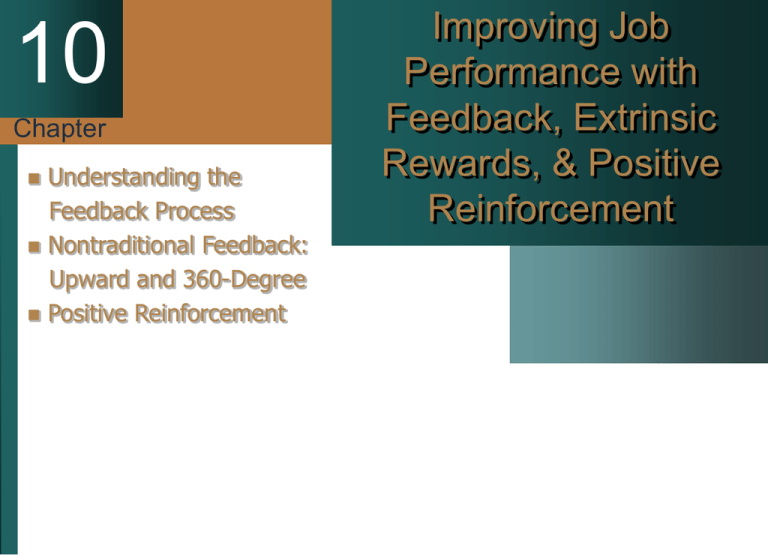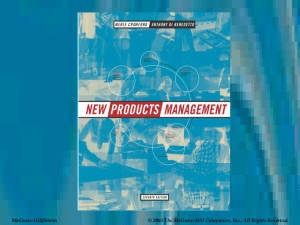
10
Chapter
Understanding the
Feedback Process
Nontraditional Feedback:
Upward and 360-Degree
Positive Reinforcement
Improving Job
Performance with
Feedback, Extrinsic
Rewards, & Positive
Reinforcement
10-3
Feedback
Feedback objective
information about performance
Functions of Feedback
McGraw-Hill
Instructional – clarifies
roles, teaches behavior
Motivational – serves as
reward
To be used effectively
managers must
understand interaction
between how feedback is
given and how feedback
is perceived
© 2004 The McGraw-Hill Companies, Inc. All rights reserved.
Cognitive Processing Model of
Feedback
10-4
Figure 10-2
Recipient
Sources
Others
Task
Self
Characteristics
Self-esteem
Self-efficacy
Needs and goals
Desire for performance feedback
Perception
Sign and content of feedback
message
Behavioral Outcomes
Direction
Effort
Persistence
Resistance
Cognitive Evaluations
Feedback accuracy
Source credibility
System fairness
Expectancies
Behavioral Standards
McGraw-Hill
© 2004 The McGraw-Hill Companies, Inc. All rights reserved.
10-5
Practical Lessons from Feedback Research
McGraw-Hill
Feedback acceptance should not be treated as a give; often
misperceived or rejected
Managers can enhance credibility as sources of feedback
by developing their expertise and creating a climate of
trust
Negative feedback is typically misperceived or rejected
Feedback is too infrequent in organizations
Feedback needs to be tailored to the recipient
© 2004 The McGraw-Hill Companies, Inc. All rights reserved.
10-6
Practical Lessons from Feedback Research
Cont.
McGraw-Hill
High performers respond to feedback that enhances their
feelings of competence and self-control
Computer-based feedback leads to greater performance
when received directly from computer
Recipients perceive feedback as more accurate when they
actively participate in the feedback session
Destructive criticism tends to cause conflict and reduce
motivation
Higher one rises in an organization the less likely they are
to receive quality feedback
© 2004 The McGraw-Hill Companies, Inc. All rights reserved.
10-8
Nontraditional Feedback
Upward
Feedback
subordinates evaluate
their boss
360-Degree
Feedback comparison of
anonymous feedback
from one’s superior,
subordinates, and peers
with self-perceptions
McGraw-Hill
© 2004 The McGraw-Hill Companies, Inc. All rights reserved.
Sources and Types of Feedback in
the 360-Degree Approach
10-9
Figure 10-3
Direct
supervisor
Peers/team
members
Manager/Focal Person
Self-evaluation of a
variety of skills
Relevant others such
as customers
and suppliers
Direct
subordinates
McGraw-Hill
© 2004 The McGraw-Hill Companies, Inc. All rights reserved.
10-10
Tips for Giving Good Feedback
McGraw-Hill
Relate feedback to existing performance
goals and expectations
Give specific feedback tied to
observable behavior or measurable
results
Channel feedback toward key result
areas
Give feedback as soon as possible
Give positive feedback for improvement,
not just final results
Focus feedback on performance, not
personalities
Base feedback on accurate and credible
information
© 2004 The McGraw-Hill Companies, Inc. All rights reserved.
General Model of Organizational
Reward Systems
10-11
Figure 10-4
Organizational Reward Norms
• Profit maximization
• Equity
• Equality
• Need
Types of Rewards
Desired Outcomes
• Financial/material
(extrinsic)
• Social (extrinsic)
• Psychic (intrinsic)
• Attract
• Motivate
• Develop
• Satisfy
• Retain
Distribution Criteria
• Results
• Behavior
• Other factors
McGraw-Hill
© 2004 The McGraw-Hill Companies, Inc. All rights reserved.
Reward norms
maximization – maximizing one’s
own gain
Equity – rewards should be consistent
with contributions
Equality – rewards should be the same
for everyone
Need – rewards should not be
distributed according to contribution
Profit
Reward Distribution Criteria
– rewards are
given for tangible outcomes
Performance/actions and behaviors –
rewards are distributed for things
worker does
Nonperformance criteria – rewards are
given for things other than performance
Performance/results
Why Do Extrinsic Rewards Fail to
Motivate?
McGraw-Hill
10-12
Too much emphasis on monetary rewards
Rewards lack an “appreciation effect”
Extensive benefits become entitlements
Counterproductive behavior is rewarded
Too long a delay between performance and rewards
Too many one-size-fits-all rewards
Use of one-shot rewards with a short-lived
motivational impact
Continued use of demotivating practices such as
layoffs, across-the-board raises and cuts, and
excessive executive compensation
© 2004 The McGraw-Hill Companies, Inc. All rights reserved.
10-14
Maximizing Motivational Impact of Extrinsic
Rewards
McGraw-Hill
Make pay for performance an integral part of the
organization’s basic strategy.
Base incentive determinations on objective
performance data.
Have all employees actively participate in the
development, implementation, and revision of the
performance-pay formulas.
Encourage two-way communication so problems
with the pay-for-performance plan will be
detected early.
© 2004 The McGraw-Hill Companies, Inc. All rights reserved.
10-15
Maximizing Motivational Impact of Extrinsic
Rewards Cont.
Build the pay-for-performance plan around
participative structures such as suggestion systems or
quality circles.
Reward teamwork and cooperation whenever possible
Actively sell the plan to supervisors and middle
managers who may view employee participation as a
threat to their traditional notion of authority
If annual cash bonuses are granted, pay them in a
lump sum to maximize their motivational impact
Remember that money motivates when it comes in
significant amounts, not occasional nickels and dimes
McGraw-Hill
© 2004 The McGraw-Hill Companies, Inc. All rights reserved.
Reinforcement
of effect – behavior with a
favorable consequence tends to be
repeated and behavior with a negative
consequence tends to disappear
Operant behavior – action that is
learned when one operates on the
environment to produce desired
consequences
Law
reinforcement – strengthening behavior
by presenting something pleasing
Negative reinforcement – strengthening behavior
by taking away something displeasing
Punishment – weakening behavior by presenting
something displeasing or withdrawing something
pleasing
Extinction – weakening behavior by ignoring it or
making sure it’s not reinforced
Positive
10-16
Figure 10-5
Behavior-Consequence Relationship
Contingent Consequences in Operant Conditioning
Nature of Consequences
Contingent
Presentation
McGraw-Hill
Contingent
Withdrawal
Positive or Pleasing
Negative or Displeasing
Positive Reinforcement
Punishment
Punishment
(Response Cost)
Negative Reinforcement
(no contingent consequence)
Extinction
© 2004 The McGraw-Hill Companies, Inc. All rights reserved.
10-17
Table 10-3
Schedules of Reinforcement
Schedule
Description
Continuous
(CRF)
Reinforcer follows every response
Intermittent
Fixed ratio (FR)
Reinforcer does not follow every response
A fixed number of responses must be
emitted before reinforcement occurs.
A varying or random number of responses
must be emitted before reinforcement
occurs.
The first response after a specific period of
time has elapsed is reinforced
The first response after varying or random
periods of time have elapsed is reinforced.
Variable ratio (VR)
Fixed interval (FI)
Variable interval (VI)
McGraw-Hill
© 2004 The McGraw-Hill Companies, Inc. All rights reserved.
Learning Module B
Performance Appraisal
B-1
Performance Appraisal
Performance Appraisal
judgmental evaluation of one’s
traits, behavior, or
accomplishments as basis for
personnel decisions and
developmental plans
McGraw-Hill
© 2004 The McGraw-Hill Companies, Inc. All rights reserved.
Components of the Performance
Appraisal Process
B-3
Figure B-1
Appraiser
Appraisal Method
Outcomes
Appraisee
McGraw-Hill
© 2004 The McGraw-Hill Companies, Inc. All rights reserved.
Basic Approaches to Appraising
Job Performance
B-6
Figure B-2
The Trait Approach
Moderately
Decisive
Indecisive
How
decisive is
the
individual?
McGraw-Hill
1
2
3
Very
Decisive
4
5
© 2004 The McGraw-Hill Companies, Inc. All rights reserved.
Basic Approaches to Appraising
Job Performance
B-7
Figure B-2 cont.
The Behavioral Approach
Works alone on all
projects
Teams up with others
on most major projects
Works alone on most
projects
Teams up with others
on all major projects
Works alone about half
the time
Teamwork
(check the box
that best
describes this
individual’s
behavior)
McGraw-Hill
© 2004 The McGraw-Hill Companies, Inc. All rights reserved.
Basic Approaches to Appraising
Job Performance
B-8
Figure B-2 cont.
The Results Approach
Key result area:
Unit Sales
12-month goal:
12,000 units
Actual results:
10,500 units
Comments______________________________________
_______________________________________________
_______________________________________________
____________________
McGraw-Hill
© 2004 The McGraw-Hill Companies, Inc. All rights reserved.
Criteria of Legally Defensible
Performance Appraisal Systems
B-9
Figure B-3
A job analysis used to
develop the appraisal
system
Based on an analysis
of 51 employment
discrimination cases,
a performance
appraisal system has
a better change of
standing up in court if
it satisfies these
criteria:
McGraw-Hill
Definite standards of
performance are developed,
written, and provided to all
raters regardless of they
type of rating methods used
Raters are trained to
properly use the rating
instrument
© 2004 The McGraw-Hill Companies, Inc. All rights reserved.
Criteria of Legally Defensible
Performance Appraisal Systems
Based on an analysis
of 51 employment
discrimination cases,
a performance
appraisal system has
a better change of
standing up in court if
it satisfies these
criteria:
McGraw-Hill
B-10
Figure B-3 cont.
Formal appeal mechanisms
are developed and
performance ratings are
reviewed by upper-level
management
Performance ratings are
supported with documented
examples of behavior
Employees are given a
chance to improve their
performance by provision of
performance counseling or
corrective guidance
© 2004 The McGraw-Hill Companies, Inc. All rights reserved.
A Contingency Approach to
Performance Appraisals
Function of Appraisal
Appraisal
Method
Promotion Decisions
Trait
Behavioral
Results
Development
Decisions
Trait
Behavioral
Results
McGraw-Hill
B-11
Table B-2
Comments
Appropriate when competing
appraisees have dissimilar jobs
Appropriate when competing
appraisees have similar jobs
Same as above
Tends to cause defensiveness among
low self-esteem employees
Pinpoints specific performance
improvement needs
Identifies deficient results, but does
not tell why
© 2004 The McGraw-Hill Companies, Inc. All rights reserved.
A Contingency Approach to
Performance Appraisals
Function of Appraisal
Pay Decisions
Appraisal
Method
Trait
Behavioral
Results
Layoff Decisions
Trait
Behavioral
Results
McGraw-Hill
B-12
Table B-2 cont.
Comments
Weak performance-reward linkage
Enhances performance-reward
linkage
Same as above
Inappropriate, potentially
discriminatory
Weighted combination of behaviors,
results, and seniority is recommended
Same as above
© 2004 The McGraw-Hill Companies, Inc. All rights reserved.






